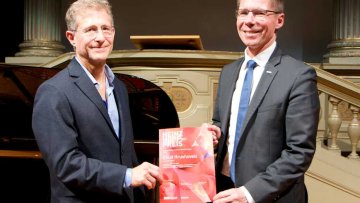Relationship between ideology and language in the Catalan independence context
Abstract
Political polarization generates strong effects on society, driving controversial debates and influencing the institutions. Territorial disputes are one of the most important polarized scenarios and have been consistently related to the use of language. In this work, we analyzed the opinion and language distributions of a particular territorial dispute around the independence of the Spanish region of Catalonia through Twitter data. We infer a continuous opinion distribution by applying a model based on retweet interactions, previously selecting a seed of elite users with fixed and antagonist opinions. The resulting distribution presents a mainly bimodal behavior with an intermediate third pole that appears spontaneously showing a less polarized society with the presence of not only antagonist opinions. We find that the more active, engaged and influential users hold more extreme positions. Also we prove that there is a clear relationship between political positions and the use of language, showing that against independence users speak mainly Spanish while pro-independence users speak Catalan and Spanish almost indistinctly. However, the third pole, closer in political opinion to the pro-independence pole, behaves similarly to the against-independence one concerning the use of language.
Ref: https://www.nature.com/articles/s41598-019-53404-x
15:30
Approximate subgroups with bounded VC dimension
Part of joint combinatorics - logic seminar. See
Abstract
This is joint with Gabe Conant. We give a structure theorem for finite subsets A of arbitrary groups G such that A has "small tripling" and "bounded VC dimension". Roughly, A will be a union of a bounded number of translates of a coset nilprogession of bounded rank and step (up to a small error).
Phase transitions in random regular graphs
We analyze the asymptotic relative size of the largest independent set of a random d-regular graph on n → ∞ vertices. This problem is very different depending on d because of a surprising phase transition. This is somewhat similar to finding the density of ``water'' above and below its freezing point. These phase transitions are related to algorithmic thresholds, mixing properties, counting, graph reconstruction, graph limits and other questions. We are still far from a complete understanding of all these questions. Our tools are partially coming from statistical physics.
Universally defining finitely generated subrings of global fields
Abstract
It is a long-standing open problem whether the ring of integers Z has an existential first-order definition in Q, the field of rational numbers. A few years ago, Jochen Koenigsmann proved that Z has a universal first-order definition in Q, building on earlier work by Bjorn Poonen. This result was later generalised to number fields by Jennifer Park and to global function fields of odd characteristic by Kirsten Eisenträger and Travis Morrison, who used classical machinery from number theory and class field theory related to the behaviour of quaternion algebras over global and local fields.
In this talk, I will sketch a variation on the techniques used to obtain the aforementioned results. It allows for a relatively short and uniform treatment of global fields of all characteristics that is significantly less dependent on class field theory. Instead, a central role is played by Hilbert's Reciprocity Law for quaternion algebras. I will conclude with an example of a non-global set-up where the existence of a reciprocity law similarly yields universal definitions of certain subrings.
Oxford Mathematician Ehud Hrushovski has been awarded the 2019 Heinz Hopf Prize for his outstanding contributions to model theory and their application to algebra and geometry.


